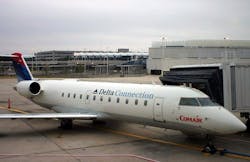Passengers hopscotching across the United States may book their trip on one of the major airlines such as United, but it's often smaller, regional carriers with such names as Colgan Air that do the flying.
Regional airlines operate half the nation's scheduled flights and are often the link between smaller communities and the national air service network.
But now, several of those carriers are being closed or are in bankruptcy court protection. They face significant challenges, as the big airlines they often fly for are phasing out smaller and costlier regional jets and cutting some low-traffic regional routes to focus on those that are more lucrative.
As a result, many smaller communities may lose some or all of their air service, and their residents will have to take longer drives to find a flight.
"We're going to see some airports go dark," says William Swelbar, research engineer for MIT's International Center for Air Transportation. "The highway is going to be the connection to the air network system."
Delta, the largest operator of 50-seat aircraft among U.S. airlines, will shutter regional carrier Comair after Sept. 29. Pinnacle Airlines, with subsidiaries such as Colgan that have flown for United, US Airways and Delta, filed for bankruptcy protection in April. AMR, the parent company of American Airlines and regional carrier American Eagle, filed for bankruptcy protection in November.
"Airlines are finding these smaller jets just don't make them any money," says industry analyst Mike Boyd. "That's why they're shutting down Comair. That's why Pinnacle is in bankruptcy. It's a sector of (the) industry that provides a type of aircraft that's rapidly becoming obsolete."
Fuel's volatility hurts
Regional airlines, which fly mostly for and under the brands of their bigger network peers, such as Delta Connection and United Express, have relied on 50-seat jets for the bulk of their trips.
But the volatile price of fuel and the high cost of maintaining aging aircraft are leading bigger airlines to shift away from smaller planes.
Delta has said the number of 50-seat jets that it flies will drop from almost 350 to 125 or less in the next several years. The airline says those cuts are a key reason for shutting down its regional subsidiary, Comair, next month.
"With the size of their fleet and higher unit costs of flying, Comair's operations are no longer sustainable in this environment," says Delta spokeswoman Kristin Baur.
Boyd says, "We think by 2016, virtually every 50-seat jet or smaller (plane) will be out of the system. Those airplanes are getting older and more expensive, and as a result, airlines are culling them out of their fleets."
Communities could lose
The flurry of airline mergers in recent years -- Delta's union with Northwest, United with Continental, and most recently, Southwest with AirTran -- also is affecting the regional flight map, says Roger Cohen, president of the Regional Airline Association.
Airlines that have joined forces and no longer compete with each other can shed less profitable routes and funnel fliers from smaller communities through hubs, Cohen says.
"That's reduced the number of regional choices for passengers," says Cohen. "There are (nearly) 500 communities in this country that rely exclusively on regional airlines for their service. Any one of them is at risk of losing (some), if not all of its connectivity to the global marketplace in this environment."
That troubles Ron Cox, who coordinates production and delivery of big purchases for his company. The Lubbock, Texas, resident says that 95 percent of his travel is on regional jets.
"Regional jets are the lifeblood of Middle America air travel," Cox says.
It also concerns Doug Gillikin, a sales representative, who regularly takes Delta Connection flights out of Louisiana's Lafayette Regional Airport.
The airport is a 12-minute drive from his Lafayette home. While he has yet to see any cuts in flights, he says he'd have to drive 60 miles to Baton Rouge or two hours to New Orleans if the flight schedule is pared.
"This would certainly be an issue," says Gillikin, who finds he's on 50-seat jets on many of his connecting flights.
Memphis is one of many midsize cities that serve as a portal for passengers in smaller communities headed to other destinations.
"We've lost a lot of markets that were served only with the 50-seat (aircraft)," says Larry Cox, president and CEO of the Memphis-Shelby County Airport Authority.
Departures in Memphis have dropped from 250 a day in 2010 to 185 this year.
Some of the communities those flights served lost air service altogether, says Cox. Others, he says, now have connecting flights through Delta's Atlanta hub, rather than Memphis.
"We'd like more flights," Cox says. "But you're not going to have any flights if the airlines don't make money, so we understand their predicament."
Delta's diminished presence in Memphis has prompted the airport to pursue low-cost carriers such as JetBlue, Southwest and Spirit for service.
Removing the 50-seat jets from Delta's fleet "will take place gradually," says airline spokeswoman Baur. They'll be replaced by larger regional and full-size jetliners, she says.
It's too soon to say which communities will retain more service, and which ones will lose.
"Our schedules are adjusted on an ongoing basis to best serve the needs of our customers," Baur says. "Therefore, it's too early for us to comment on what our domestic network will look like several years from now."
Map could be redrawn
Regional airlines also worry about a new rule being devised by the Federal Aviation Administration that would require co-pilots to have the same 1,500 hours in the air as captains.
The rule stems from the Feb. 12, 2009, crash of a regional Colgan Air flight near Buffalo, in which 50 people were killed. Colgan was flying the Newark-to-Buffalo route as a Continental Connection flight.
The industry has warned that the rule, expected to take effect in August 2013, could result in fewer pilots to fly regional routes, that they'll go to better-paying jobs at big airlines, or even to piloting cargo or business jets.
Many smaller cities could be left with fewer flights or no flights at all.
"By 2018, about 100 fewer airports will be served, but that doesn't mean 100 (more) communities won't have air service," industry analyst Boyd says. "You have to drive a little farther to get access to and from the rest of the world, but in most cases, it's not onerous."
Many people living in smaller cities already bypass the local airport to drive to a larger one farther away, where there are more flight options and lower fares, Swelbar says.
Swelbar predicts that maybe only "a handful" of regional airlines will survive the current turmoil in the industry. But, he says, they could thrive by returning to their roots, flying independently and providing service to smaller markets that are left behind by larger airlines.
"As communities see a loss of service or shift of service, it creates an opportunity for regional carriers to begin to operate on their own, independently, between those communities, which is really how the industry started," Cohen says.
Turboprops, and even nine-seat aircraft, are good options for some low-traffic routes, says Cohen.
But, he adds, the regional airline industry's 50-seat mainstay shouldn't be counted out just yet.
"When (oil) was at $100 a barrel, then it becomes a whole lot less fuel-efficient than it might be at even $90 or $80, which we've seen over the last six months, in which case they become profitable again," Cohen says.
"Those economics can turn on a dime."
Copyright 2012 Gannett Company, Inc.All Rights Reserved



